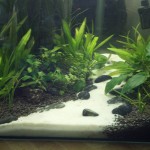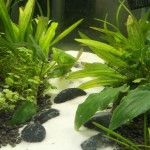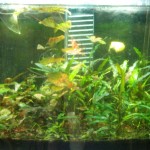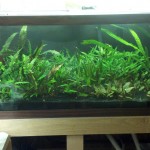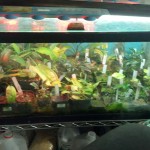June 2012 Meeting
Sean Murphy hosted GWAPA on June 23rd in his home in Germantown, MD. Joshua Weigert spoke on carnivorous plant species.
Joshua began with a couple of “FAQs”, the first being Why Carnivorous Plants? We naturally have a bias in favor of animals, being animals ourselves. Shown a picture of a cow in a grassy field, we would be more likely to it’s a picture of a cow, than a picture of grass. But plants have a lot of very interesting behaviors. Plants communicate, by releasing chemicals. Plants can go to war with each other. Tannins are an example of chemical warfare. Plants can form advanced communities. And yes, there are plants “that eat stuff.”
Which brings us to the second FAQ: Can Carnivorous Plants Eat Fish? It’s worth noting that carnivorous plants don’t get energy from what they “eat” as we do. They get energy from photosynthesis, just like other plants. Rather than “eating” animals, it is probably more correct to say that they are “gratuitously killing animals and using them for fertilizer.” In a breeding tank, it is possible to occasionally lose a fry or very small fish to carnivorous plants, but this is not the norm.
Joshua then gave a run down of numerous carnivorous plants.
Aldrovanda is one of the more interesting plants. It is “kind of and aquatic venus flytrap” feeding on daphnia and mosquito larvae. Every single leaf ends in a trap. There is a beautiful red form of aldrovanda. This is not a good aquarium plant, due to its very particular needs. It requires low nutrient levels, very acidic water, and bright, indirect light. Josh has successfully grown it in a 2.5 gallon aquarium with duckweed on the surface, lots of light, and peat moss to acidify the water.
There are over 200 species of Utricularia, commonly known as bladderworts. They live in moist swamp soil, and many are amphibious. They have beautiful flowers. Utricularia fall into three groups: pest plants, those that look like stem plants, and those that look like grasses.
Utricularia gibba often shows up as an uwelcome pest in planted tanks. It looks a lot like string algae, with very small bladders. Some people use it in fry tanks to eat excess microworms and vinegar eels. U. gibba has “stunning yellow flowers.”
The stem plant type bladderworts are all fully aquatic. Most are fairly similar looking. They are “great flowering plants.” Some have large bladders. The number of bladders depends upon the nutrient levels where they are growing.
Utricularia aurea is commonly known as “golden bladderwort” or “hobby bladderwort.” it is easy to grow, and works well in an aquascape. It does have big bladders, something to consider.
Utricularia macrohiza (N. America) and Utricularia vulgaris (Europe and Asia) appear identical, with remarkably similar flowers. Plant color varies from green to pinkish red in color, and they have a lot of bladders. U. macrohiza is native to our area, and most of North America.
Utricularia purpurea is also native to this region. It is a very pretty aquatic plant, more red than U. macrohiza, and with purple flowers instead of yellow. U. macrohiza and U. pupurea are both easy to find. They are very fast growing, and can be invasive. They can take over an entire body of water. Be very careful with these plants, and don’t ever transport them to any other body of water. Dry plants out thoroughly before disposing of them.
Takashi Amano uses the grassy bladderworts in some of his aquascapes. The bladders are attached to the roots. Most of these plants are amphibious.
Utricularia graminifolia is the most familiar of the grassy type bladderworts. It is used in a lot of aquascapes. It has lots of pretty white flowers when grown emersed. It can be difficult to grow, and needs soft acidic water.
Utricularia sandersonii is similar to U. graminifolia, but is easier to grow.
Utricularia praelonga is almost identical to U. graminifolia, but the tops of the leaves have a notch. It is easy to grow.
Utricularia livida has very round leaves. It looks a lot like duckweed might look if forced to grow underwater. It is very easy to grow underwater. It is also very easy to grow in a terrarium, and produces lots of flowers.
Carnivorous Plant Nursery in Derwood, MD is an excellent resource for carnivorous plants and information about them. They can be visited, by appointment only. They also have an online presence at http://www.carnivorousplantnursery.com/
The meeting concluded with our usual mini-auction.
GWAPA is looking at possible group orders for ADA and Seachem products. Watch the forum for details. Julie Weis is now head of the Food Committee, and Joshua Weigert has taken on responsibility for the group’s Facebook page.
Don’t forget about the club’s aquascaping contest currently underway. This year’s theme is Nature Aquarium Style. Tank photos are due November 18.
We are still organizing the August Tank Tours. Sign up on the forum; there is already a thread started.
Next month’s meeting will be July 28 at the Walker Nature Education Center, in Reston, VA, with Karen Randall the featured speaker.
